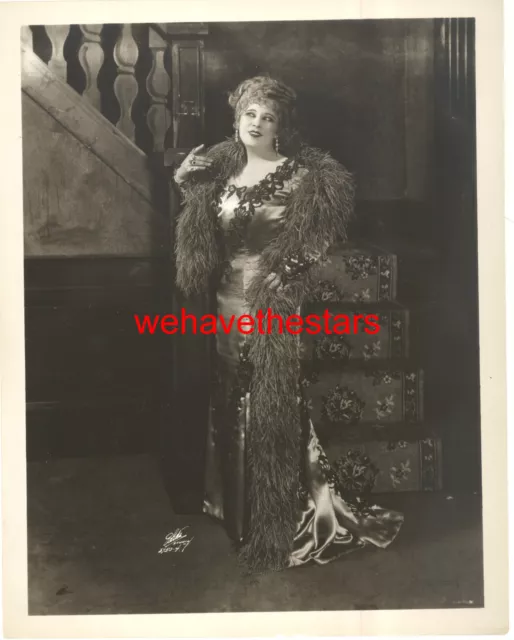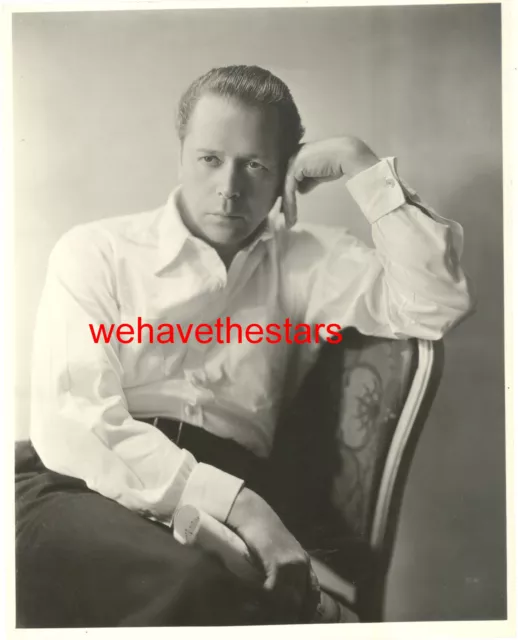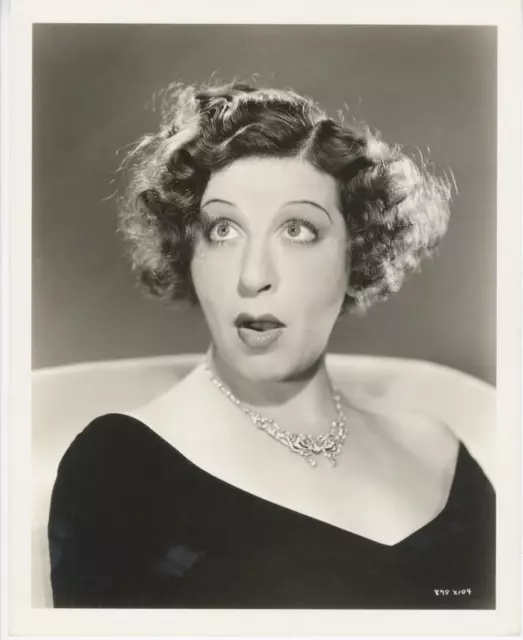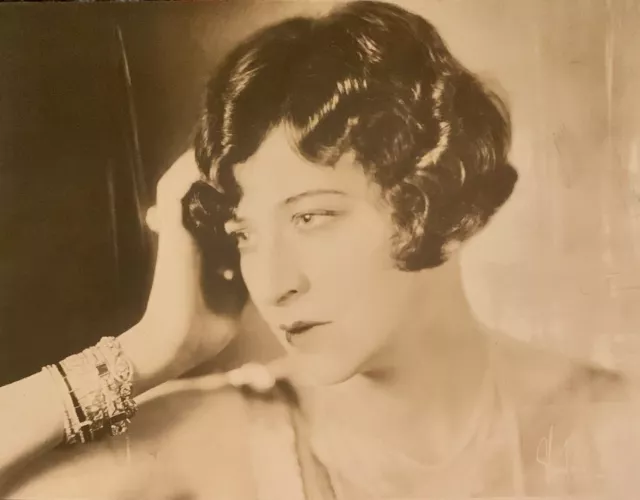Fanny Brice Original Double Weight Publicity Portrait by Strauss Peyton Studio
Strauss-Peyton was Kansas City's most innovative portrait studio refining a method of background painting on the negative that made the hand of the artist visible in every image. Benjamin R. Strauss (1871-1952) and Homer K. Peyton collaborated in the creation of the portraits from 1903 until 1926 when each went his separate ways. Their style of photography would be imitated by other Kansas City camera artists--David Baker, Orville Hison, H. Kenyon Newman, James A. Wiese, and the photographers of Bert Studio. Indeed, the community of artistic portraitists inspired by Strauss-Peyton would constitute the most important school of celebrity portraiture developed outside of New York and Hollywood during the first half of the 20th century.
Ben Strauss, brother of St. Louis' principal commercial photographer at the beginning of the 20th century, Julius Caesar Strauss , was born and educated in Cleveland, Ohio, then professionally trained by his brother in St. Louis. Ben briefly operated a studio in Louisville, Kentucky, before moving to Kansas City in 1900. There Strauss began working with motion picture pioneer George W. Curtiss, who had operated in Kansas City since 1894. The team's studio was renamed Strauss Studio by 1903. The following year Strauss Studio moved to 216 E. 11th Street.
Strauss built his clientele through connections at his Jewish synagogue, whom he portrayed in rather formal, straight sittings. The studio's reputation blossomed, however, when Strauss hired the extremely talented Homer K. Peyton, a native of Omaha, who became an artistic collaborator. By 1908 Peyton was an equal partner and the following year Strauss-Peyton Studio was first listed in local city directories at 3109 Troost Avenue.
In 1910 a second location was opened at 1026 Walnut. In 1915 Strauss-Peyton Studio opened a third parlor at the prestigious Muehlebach Hotel at 103 W. 12th Street in downtown Kansas City. Although the Walnut location was closed in 1916, the Troost and Muehlebach locations were operational through 1926. In 1921 Strauss erected a three-story warehouse and workshop at 1717 Baltimore Street for the storage and renovation of his 100,000 glass plate negatives.
Early on in their partnership Strauss and Peyton determined on a diversified approach to their business. They supplied society portraits to the Kansas City Star, home portraits to local citizens, and celebrity portraits of performers operating in the several vaudeville and theatre circuits that ran through Kansas City. During the First World War, they determined to open a summer branch in New York City. It operated during that period when most New York City cameramen shuttered their studios and headed to the resorts.
Homer Peyton was the more peripetetic of the partners. As early as 1912, he traveled to Denver with his assistant Richard Irwin, Jr., to conduct annual sittings. During World War I, Omaha became a regularly serviced city. Wilbert T. Love, another of the cameramen at the studio, also traveled western cities in the 1910s doing sittings. Peyton later handled the summer work in New York. Early in the 1920s they established a permanent station in New York, but Peyton's insistence on concentrating the business on celebrity portraiture irked Strauss. Strauss preferred running a diversified business headquartered in Kansas City. In 1929 a Cleveland newspaper chronicled the end of the partnership: "The lure of New York struck the boys and they moved into the finest studio in Manhattan. Business was sensational, until one day the partners argued and Ben walked out. He was tired out." Strauss sold the Kansas City studio to Reginald A. Poissant DeCloud, owner of the Cornish-Baker studio, in 1926. Strauss moved to Cleveland, the city of his nativity, and set up Ben Strauss Studios in the Hollendon Hotel.
From 1926 until the Stock Market Crash, Homer Peyton kept the New York City studio operating. Then respiratory difficulties and the uncertain financial scene caused him to cross to continent, seeking a climate suitable for recovery. He moved to Seattle, intending only to stay during the summers, but in August 1930 opened a studio in the Olympic Hotel.
The earliest negatives still extant from the Strauss-Peyton Portrait Studio date from Strauss-Peyton's origin in 1908 through the 1940s. Of the nearly 80,000 existing original sitting cards detailing the Studio's daily portrait schedule during this time, only about 10,000 images may have survived. They comprise five tons of early, very fragile, glass plate negatives (and later acetate negatives), and are preserved in the Jackson County Historical Society Collection.
NOTES: "On the Avenue after 6 P.M." Cleveland Plain Dealer (Jun 28, 1929), 20. David S. Shields/ALS
Specialty:In the 1910s, Benjamin Strauss specialized in formal portraits of Kansas City notables. After he added Homer Peyton as partner, the business expanded to theatrical photography. Peyton was the graphic artist, performing pictorialist manipulations of the negative to form aesthetic backgrounds, sculpt shadows, and supply tonal drama. Strauss-Peyton's large format prints are particularly noteworthy for their richness of texture.
Because of Kansas City's importance as a transportation hub, it was the juncture of three different theatrical circuits. Strauss-Peyton, like their rivals, Orval Hixon and James Hargis Connelly , secured a national reputation as celebrity portraitists. Images regularly appeared in 1920s movie and theater magazines.
- Size: 7"x9 1/4"
- Modified Item: No
- Country/Region of Manufacture: United States
- Original/Reproduction: Original
- Object Type: Photograph
- Industry: Theater
PicClick Insights - Fanny Brice Original Double Weight Publicity Portrait by Strauss Peyton Studio PicClick Exclusive
- Popularity - 2 watchers, 0.0 new watchers per day, 1,005 days for sale on eBay. Good amount watching. 0 sold, 1 available.
- Best Price -
- Seller - 652+ items sold. 0% negative feedback. Great seller with very good positive feedback and over 50 ratings.
People Also Loved PicClick Exclusive

VINTAGE Mae West DIAMOND LIL 1929 BROADWAY Publicity Portrait by WHITE STUDIOS
$155.96 Buy It Now 8d 3h
VINTAGE Theodore Kosloff RUSSIAN BALLET DANCER 30s Publicity Portrait by ARKATOV
$119.96 Buy It Now 15d 4h
VINTAGE Anna Held HOURGLASS FIGURE ZIEGFELD STAR '28 THEATER Publicity Portrait
$155.96 Buy It Now 23d 3h
Original RUTH ST DENIS Modern Dancer AUTOGRAPHED Strauss Peyton Portrait PHOTO
$535.50 Buy It Now 10d 4h
VINTAGE Montgomery Clift & CAST THEATER '54 DBW Publicity Portrait by VANDAMM
$155.96 Buy It Now 4d 4h
Fanny Brice-Original Photo-Portrait-Double Wgt-Clarence S Bull Stamp
$99.99 Buy It Now
FANNY BRICE Singer Actress BABY SNOOKS Vintage 5.75x9 Double Weight Photo 1950
$14.99 Buy It Now or Best Offer

